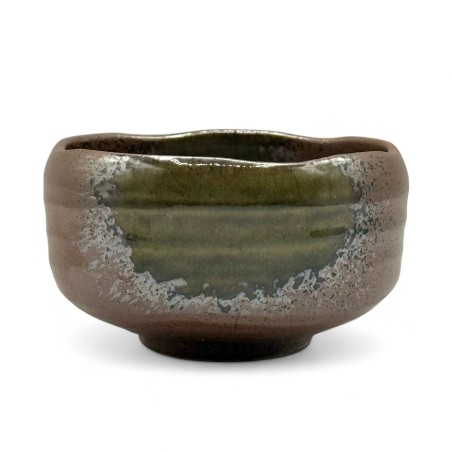


Bring authentic elegance and traditional craftsmanship to your matcha ritual.
Origin & Tradition
Handcrafted in Gifu Prefecture, the heart of Mino‑yaki (美濃焼), a pottery tradition dating back to the 7th century (pinterest.com).
Striking Aesthetics
Features a rich Nanban-brown exterior that flows into a deep, earthy glaze at the center—each bowl exhibits unique variations created through wood-like kiln effects .
Size & Capacity
Measures approximately 5.1" (13 cm) in diameter by 2.9" (7.5 cm) high, with a generous ~18 oz (532 ml) capacity—ideal for both frothy usucha and thicker koicha matcha (inouetea.com).
Crafted for Tea Ceremony
The broad, rounded form is excellent for whisking with a bamboo chasen, while the comfortable foot (kodai) supports easy handling and an authentic chanoyu experience.
| Feature | Description |
|---|---|
| Material | High-fired ceramic, kiln-fired for durability |
| Finish | Rustic, semi-gloss glaze—colors and texture vary per bowl |
| Usage | Primarily for matcha preparation, but equally suited for serving rice, desserts, or as a decorative piece |
| Care | Hand-wash recommended to preserve glaze beauty and prevent abrupt thermal stress |
Versatile functionality: Designed for culinary and aesthetic delight alike.
Mindful artistry: Each piece reflects the wabi‑sabi philosophy—beautiful imperfection, unique form, one-of-a-kind glaze.
Cultural resonance: Rooted in centuries-old Japanese tea traditions, it makes a meaningful gift or a cherished addition to any tea lover’s collection.
Elevate your tea experience with this exquisite Nanban Brown Mino‑yaki Chawan — where form meets function, tradition meets beauty, and every sip becomes a ritual.

Shopping Secure Certificate

We ship within 1-4 business days

Our Shipping Partner
Bring authentic elegance and traditional craftsmanship to your matcha ritual.
Origin & Tradition
Handcrafted in Gifu Prefecture, the heart of Mino‑yaki (美濃焼), a pottery tradition dating back to the 7th century (pinterest.com).
Striking Aesthetics
Features a rich Nanban-brown exterior that flows into a deep, earthy glaze at the center—each bowl exhibits unique variations created through wood-like kiln effects .
Size & Capacity
Measures approximately 5.1" (13 cm) in diameter by 2.9" (7.5 cm) high, with a generous ~18 oz (532 ml) capacity—ideal for both frothy usucha and thicker koicha matcha (inouetea.com).
Crafted for Tea Ceremony
The broad, rounded form is excellent for whisking with a bamboo chasen, while the comfortable foot (kodai) supports easy handling and an authentic chanoyu experience.
| Feature | Description |
|---|---|
| Material | High-fired ceramic, kiln-fired for durability |
| Finish | Rustic, semi-gloss glaze—colors and texture vary per bowl |
| Usage | Primarily for matcha preparation, but equally suited for serving rice, desserts, or as a decorative piece |
| Care | Hand-wash recommended to preserve glaze beauty and prevent abrupt thermal stress |
Versatile functionality: Designed for culinary and aesthetic delight alike.
Mindful artistry: Each piece reflects the wabi‑sabi philosophy—beautiful imperfection, unique form, one-of-a-kind glaze.
Cultural resonance: Rooted in centuries-old Japanese tea traditions, it makes a meaningful gift or a cherished addition to any tea lover’s collection.
Elevate your tea experience with this exquisite Nanban Brown Mino‑yaki Chawan — where form meets function, tradition meets beauty, and every sip becomes a ritual.
Japanese matcha bowls: As one of the central elements of every Japanese tea ceremony, clay tea bowls have always had a special place in the Japanese culture of Chado (also Sado: way of tea). In addition to tea caddies, matcha bowls were also given away to particularly valued subjects at the time of the shoguns, which shows us the value of this utensil. Unique items from Japanese master potters fetch prices over a thousand euros today. In Japanese, matcha bowls are called chawan or matchawan. Chawan simply means tea bowl.
In addition to individual pieces, we also offer matcha bowl sets, which usually contain a matcha broom and a matcha spoon in addition to the actual tea bowl.
Matcha bowls from Japan are generally not suitable for the dishwasher, but should be washed out with warm water without detergent and wiped dry as soon as you have consumed the green tea.